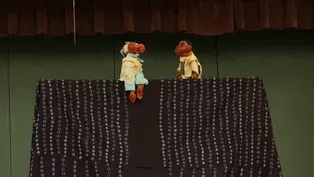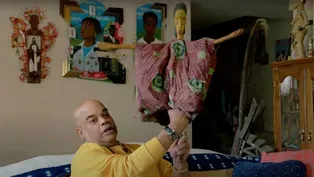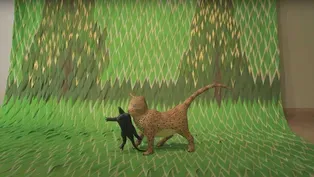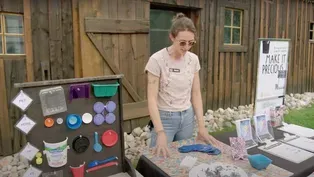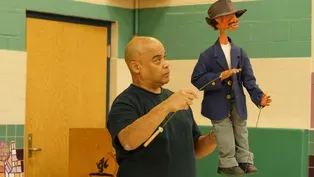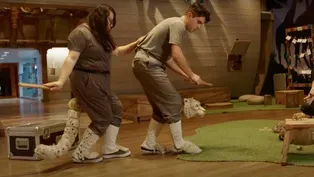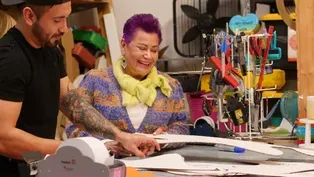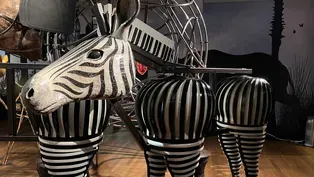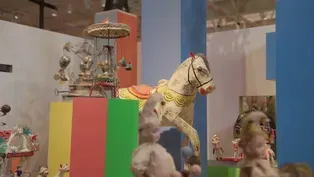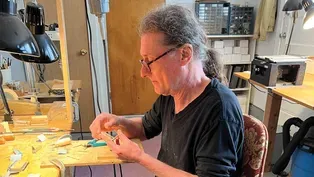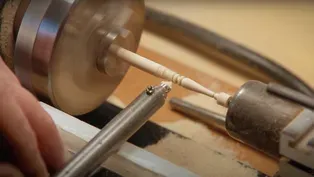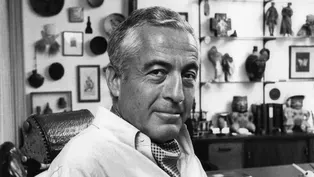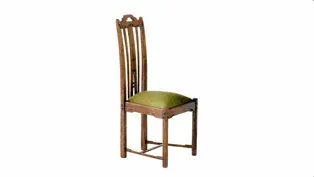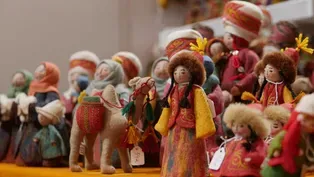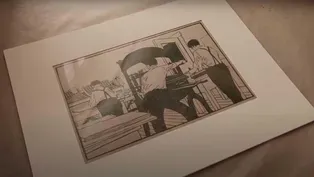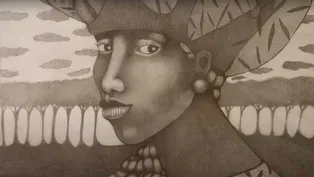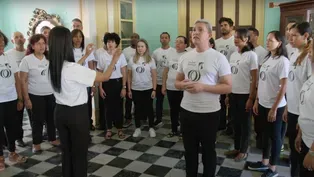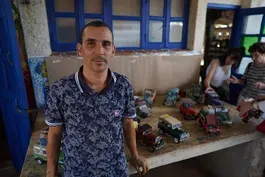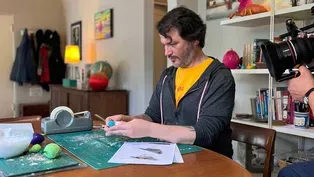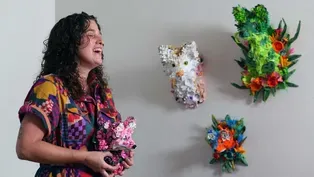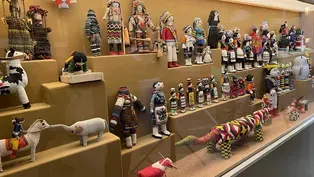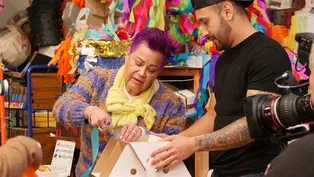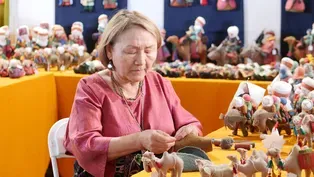
International Folk Art Market segment
Clip: Season 15 | 9m 5sVideo has Closed Captions
Meet artisans at the International Folk Art Market
Travel the globe at the annual International Folk Art Market in Santa Fe, New Mexico, where artists and makers from around the world including Mexico, Peru, Kyrgyzstan, Ukraine, Eswatini, and more share their practices and culture through miniature folk art and other craft traditions. Segment from the MINIATURES episode
Problems with Closed Captions? Closed Captioning Feedback
Problems with Closed Captions? Closed Captioning Feedback

International Folk Art Market segment
Clip: Season 15 | 9m 5sVideo has Closed Captions
Travel the globe at the annual International Folk Art Market in Santa Fe, New Mexico, where artists and makers from around the world including Mexico, Peru, Kyrgyzstan, Ukraine, Eswatini, and more share their practices and culture through miniature folk art and other craft traditions. Segment from the MINIATURES episode
Problems with Closed Captions? Closed Captioning Feedback
How to Watch Craft in America
Craft in America is available to stream on pbs.org and the free PBS App, available on iPhone, Apple TV, Android TV, Android smartphones, Amazon Fire TV, Amazon Fire Tablet, Roku, Samsung Smart TV, and Vizio.
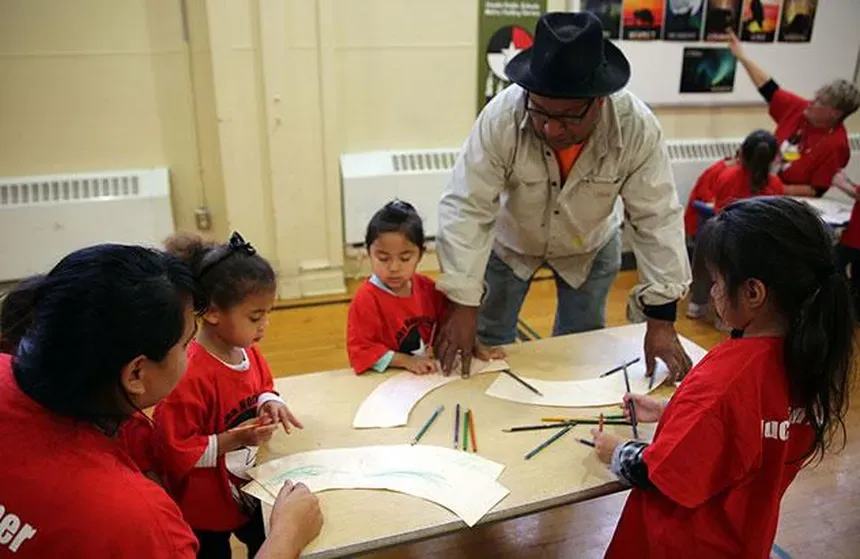
Education Guides
Download Craft in America education guides that educate, involve, and inform students about how craft plays a role in their lives, with connections to American history and culture, philosophies and science, social causes and social action.Providing Support for PBS.org
Learn Moreabout PBS online sponsorship♪♪ Laura: The Museum of International Folk Art in Santa Fe opened in 1953.
It is full of marvelous miniature imagined worlds.
The term folk art in many people's minds is kind of a diminishment, and that's not at all how we feel about it.
It's masterful work by people who excel in their craft.
In 1982, we opened the exhibition "Multiple Visions: A Common Bond," which is a show with over 10,000 objects all gifted to the museum by Alexander Girard.
Charlene: Alexander Girard grew up in Italy, outside of Florence in a villa, and in 1932, he had come to the United States, and he was wandering around, he told me, in Greenwich Village, and he suddenly saw this spatter-painted clay bank from Mexico.
It transformed his life actually.
It just made him realize he had to have more of this, and he had to understand what were the motivations and meaning of folk art.
Laura: He was a very well-known mid-century designer.
He became the head of the textile division at Herman Miller, the furniture company.
He injected color and pattern and texture, bringing a little more joy to modern design.
He could do his job anywhere, so in 1953, he and his wife Susan moved to Santa Fe, but they had already started their voracious collecting of both toys and folk art, which ultimately reached 106,000 objects.
♪♪ Charlene: In October of 1978, many, many beer boxes that looked like this arrived here at the museum.
This was box 3,837.
Plus hundreds of crates for the larger items, and those were all stored in the auditorium.
I was the curatorial coordinator, and as we were unpacking this collection, a lot of which he hadn't seen since he packed it, the joy that Mr. Girard felt was palpable.
He was just having the greatest time.
It took over two years, with the help of cultural advisors, 30 volunteers, and the entire staff to build this installation.
♪♪ Laura: Alexander Girard designed and curated.
He had a hand in placing every object.
He created what he called sets.
They're kind of these villages in miniature.
This is the 40th anniversary of the collection being on display exactly as he created it.
So this set is a miniature representation of an actual town in Mexico called Acatlán de Osorio.
♪♪ Miniatures are a really popular and rich tradition in Mexico.
Alexander Girard would buy lots of these ceramic figures, and then he would animate the whole set by having them interact with each other.
Charlene: He would layer and layer.
He would add more things to the back.
He would--you know, he just-- he definitely had a vision in his mind.
He often referred to these figurative ceramics as people because they were people who were inhabiting this scene.
The "Puebla Kitchen" set represents miniatures of all different types that are made in Mexico, and so you've got the straw work, metalwork, and ceramic dishes that are so tiny you can't imagine how the person made them.
Charlene: He told me that he was in a small Mexican village and he discovered these clay cacti.
He said, "I want more of these," so he returned and he said, "No, I mean, I really want more of these."
The fields stopped being plowed.
I mean, the whole village was put to work making cacti for this American folk art collector.
Laura: Whereas many of the villages that Girard created in multiple visions were specific to a country or a culture, this one, "The Grand Canal," also known as "The Harbor Scene," is really kind of a mash-up.
So we've got European and Asian towns on either side of the harbor.
The waterway is actually created out of shower glass, and there are in this set both toys and folk art mixed together.
Charlene: Mr. Girard did not drive, so every morning, I would pick him up after breakfast and then also drive him home after his afternoon work.
One day, he said to me, "Would you mind taking me to Kmart?"
Ha!
And I thought, "OK." And he made a beeline right to the toy department.
He bought a ape.
Then he went to the pet department and bought a cage into which he placed the ape.
I just realized this is a man who is so visual, he has no blinders on.
Laura: The "Circus" set is mostly manufactured toys and antique ones.
Alexander Girard designed the exhibition to be an experience of discovery.
There's no object labels.
He didn't want labels.
He wanted people to bring their own interpretation to it.
♪♪ Charlene: Mr. Girard grew up in an Italian villa, and this is an autobiographical set.
There are pieces that were made by his brother, actually a well-known Italian ceramic artist, and then within the house, some beautiful watercolors by his good friend Georgia O'Keeffe.
♪♪ Laura: This set is known as "Christening."
It is this gathering of people to witness this momentous occasion.
The space looks much deeper than it actually is because Girard used diminishing-sized figures as you went back.
Charlene: I think it does express in a beautiful way his vision for the whole gallery, which is to evoke common humanity.
Laura: And his guiding principle was an Italian saying, "Tutto il mondo e paese," which to him meant "All the world is hometown."
Charlene: It was part of his plan to stop visitors in their tracks and, you know, make them really look... but he also said time and time again to me, "We want to have so much stuff in here that people will always have a reason to come back."
I do want to say, after 40 years, I still find things in this gallery that I hadn't noticed before.
♪♪
Woodblock print & marionette maker Gustave Baumann segment
Video has Closed Captions
Multidisciplinary artist, Gustave Baumann, was deeply inspired by Santa Fe (12m 16s)
Underground Railroad, Not a Subway by Schroeder Cherry
Video has Closed Captions
Schroeder Cherry's puppetry performance, Underground Railroad, Not a Subway (25m 34s)
Schroeder Cherry's Civil Rights Childrens Crusade
Video has Closed Captions
Schroeder Cherry's puppetry performance, Civil Rights Childrens Crusade (9m 53s)
Schroeder Cherry's African Puppets
Video has Closed Captions
Artist, puppeteer, museum educator Schroeder Cherry on African puppets in his collection (2m 36s)
Roberto Benavidez on creating piñatas & "piñathkos"
Video has Closed Captions
Artist Roberto Benavidez speaks with curator and art historian on his piñatas & piñathkos (1m 49s)
Recycling plastic through Precious Plastic program
Video has Closed Captions
Sustainability coordinator on recycling plastic through their Precious Plastic program (54s)
Puppeteer Schroeder Cherry segment
Video has Closed Captions
How puppets can become vehicles of history & change: the work of Schroeder Cherry (10m 29s)
Puppeteering the snow leopard at Noah's Ark
Video has Closed Captions
Kinetic designer Chris Green works with Noah's Ark educators on puppeteering snow leopard (1m 47s)
Piñata maker Lorena Robletto segment
Video has Closed Captions
Lorena Robletto creates festive and creative piñatas with fair labor practices at her business, Amaz (6m 14s)
Noah's Ark at the Skirball segment
Video has Closed Captions
Noah's Ark animals made using repurposed materials & Skirball's puppet fest (12m 10s)
Multiple Visions: A Common Bond
Video has Closed Captions
Alexander Girard's folk art collection at Museum of International Folk Art Museum (1m 20s)
Miniaturist Mark Murphy segment
Video has Closed Captions
Woodworker makes tiny furniture: Meet miniaturist Mark Murphy (10m 31s)
Mark Murphy shows us his miniature furniture
Video has Closed Captions
Miniaturist Mark Murphy shows us his miniature 1/12th scale furniture (2m 19s)
Lloyd Cotsen & the Cotsen Children's Library segment
Video has Closed Captions
Lloyd Cotsen founded the Cotsen Children’s Library at Princeton University (5m 45s)
Video has Closed Captions
Lloyd Cotsen's collection of Chinese bronze mirrors, textiles, folk art, Japanese baskets (5m 22s)
International Guild of Miniature Artisans
Video has Closed Captions
Barbara Davis on the International Guild of Miniature Artisans and their Guild School (2m 27s)
International Folk Art Market segment
Video has Closed Captions
Meet artisans at the International Folk Art Market (9m 5s)
International Folk Art Market basket weaver
Video has Closed Captions
Master basket weaver Nelsiwe Dlamini at International Folk Art Market (1m 57s)
Gustave Baumann's Printing the Democrat woodblock print
Video has Closed Captions
Thomas Leech on Gustave Baumann's woodblock print, The Print Shop/Printing the Democrat (1m 10s)
Video has Closed Captions
JELMA curator Schroeder Cherry invites artist Espi Frazier to show her work in the gallery (1m 16s)
El Orfeon Santiago Chorus performance - bonus video from MINIATURES (1m 23s)
Cuban artist Leandro Gómez Quintero segment
Video has Closed Captions
Small scale model cars by Cuban artist Leandro Gómez Quintero (13m 43s)
Calder Kamin on Austin Creative Reuse
Video has Closed Captions
Artist Calder Kamin on how she discovered Austin Creative Reuse (1m 18s)
Artist Roberto Benavidez segment
Video has Closed Captions
Roberto Benavidez's piñatas inspired by medieval manuscripts (8m 24s)
Video has Closed Captions
Calder Kamin creates an art installation by reusing and recycling discarded plastic (10m 6s)
Alexander Girard's miniature folk art collection segment
Video has Closed Captions
Alexander Girard's miniature folk art collection hopes to evoke common humanity. (8m 6s)
Video has Closed Captions
Watch a preview of PLAY, streaming Dec 1, broadcast premiere Dec 29 (1m)
Video has Closed Captions
Watch a preview of MINIATURES, streaming Dec 1, PBS broadcast premiere Dec 29 (1m)
Providing Support for PBS.org
Learn Moreabout PBS online sponsorshipSupport for PBS provided by:

